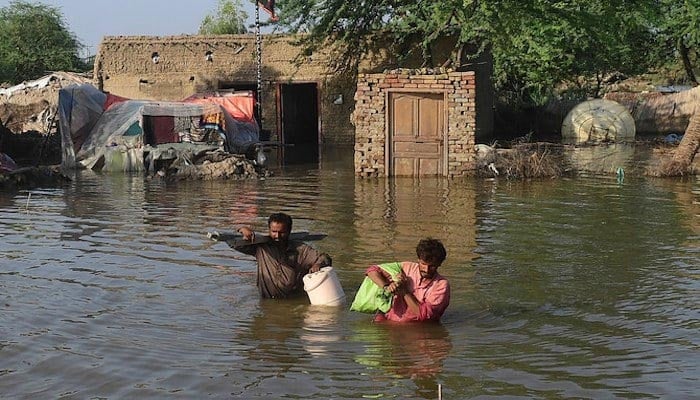8 million people in need of medical assistance after calamitous floods: UN agency
13.5 million people in need of protection services, while floods also impacted education of 3.5 million children
November 15, 2022

- 13.5 million people in need of protection services.
- Floods also impact education of 3.5 million children.
- A total of 33 million people have been affected.
As many as eight million people in flood-hit areas need medical assistance, a UN agency has said in its 100-day report, as diseases continue to spread unabated.
The report, published by the UN Office for the Coordination of Humanitarian Affairs (UNOCHA), said that about 13.5 million people are in need of protection services while the floods have impacted the education of 3.5 million children.
Flooding and standing waters have unleashed waves of water and vector-borne diseases, and millions of people are facing food insecurity, the 100-day report of the UNOCHA said, adding that access to drinking water, sanitation and hygiene remains a challenge.
"Shelter is also a high priority as winter sets in and millions still wait for their land to dry. Survivors are returning home to destroyed houses, ruined crops, and dead livestock," it said.
The report mentioned that people are displaced from place to place and protection of the most vulnerable and continued learning for children are of key concern.
People affected
The report said that about a total of 33 million people have been affected with 20.6 million still in need of assistance. However, 9.5 million flood affectees have been provided assistance.
Not just that, the winter season is fast approaching, and the affected population will be severely affected by the harsh weather conditions in a few weeks, requiring adequate shelter and non-food items such as tents and blankets, it added.
Flood water
According to the report, the flood water continued to recede in many areas of Balochistan and Sindh during the last weeks, although standing water remains in some districts. In Sindh, the most affected districts, such as Dadu, Khairpur and Mirpurkhas, remain underwater for nearly two months.
Economy
The economic situation of Pakistan is expected to have a detrimental impact according to the post-disaster needs assessment (PDNA), which was completed under the leadership of the Ministry of Planning and Development with the Asian Development Bank, European Union, World Bank, and the United Nations system, the report said.
"The economy has suffered a loss of $15.2 billion while it requires $16.3 billion for rehabilitation. The floods have increased the poverty rate by 4% while up to 9.1 million people are below the poverty line."
Pakistan requires a total of $816 million to meet its needs out of which $171 million has been funded while the remaining amount is $644.5 million.
Infrastructure
As far as the infrastructure is concerned, 13,000 road lengths and 439 bridges have been damaged by the cataclysmic floods, the report mentioned.
To date, more than 2.3 million houses have been damaged including 900,000 houses that are fully damaged across the country. Based on currently available data, some 5.4 million people remain displaced due to heavy rains and floods.
Protection
The report further said that increased protection concerns include high levels of psychological distress and exposure of children and adults to a range of new flood-related physical risks and hazards, such as damaged buildings, drowning and snakebites.
Marginalised people including people with disabilities are experiencing increased vulnerability due to disrupted access to essential services, and children and marginalised groups are vulnerable to abuse, violence and exploitation at distribution points, it said.
The report added that safety issues have also reportedly arisen from the lack of proper toilets and bathing facilities.
"The impact of floods have a negative impact on women’s and girls’ privacy, safety and security and access to basic humanitarian assistance, which has worsened pre-existing gender inequality, escalated needs for GBV services and risk mitigation across all sectors including higher risks of child marriages, harassment and possible trafficking."
Sanitation facilities
As many as six million people no longer have access to home sanitation facilities, it said.
The report stated that the availability of safe water and sanitation remains limited, with people using contaminated water for household consumption and suffering from waterborne diseases. The practice of open defecation has increased from one-fifth before the floods to over one-third of the affected population.
Health
Meanwhile, eight million flood victims need health assistance. According to the National Disaster Management Authority (NDMA), over 1,700 people died and 12,800 people were injured as a result of the heavy rains and floods.
"Cases of water and vector-borne diseases, along with acute respiratory illnesses, especially among children and old age people, remain a challenge for the public health situation in flood-affected areas of Sindh and Balochistan."
As of November 8, around eight million flood-affected people need health assistance, including the provision of essential medical supplies, and access to essential health care it said.
The report said that as the displaced people return to their places of origin, they face an increased risk of disease transmission driven by damaged infrastructure, stagnant water, and inadequate sanitation facilities.
Education
It added that apart from that, the floods have severely affected the education sector disrupting the school year and children's access to learning.
As of 20 October 2022, at least 26,632 schools have been damaged or destroyed in Sindh, Balochistan, Punjab and Khyber Pakhtunkhwa due to floods. Based on current estimations, more than 3.5 million children's education has been interrupted due to floods all over Pakistan.
Nutrition
The rate of stunting among children, which was already high before the floods, will further compound children's cognitive development. Malnourished pregnant women are also at risk of low-birth-weight babies who will be malnourished.
According to UNFPA, as of 19 October, more than 1.6 million women are of reproductive age, and nearly 130,000 are pregnant.
For these women, the risk of displacement, injury and death due to the flooding compounds with that of gender-based violence and the possibility of dangerous disruptions to reproductive health care.
Food security, agriculture and livelihoods
A total of 4.4 million acres of crop area in the country remains affected. The ongoing economic crisis due to rising inflation, low productivity growth and stagnant floodwater continues to present challenges to food security in flood-affected areas.
An estimated 14.6 million people require emergency food assistance from December through March 2023, representing an increase of more than 100% of the pre-flood estimate.











